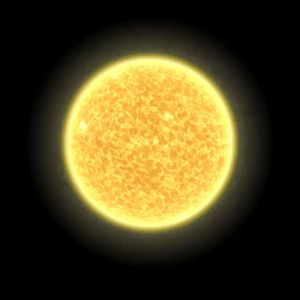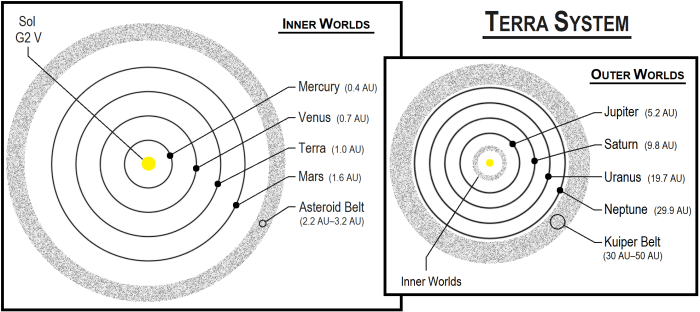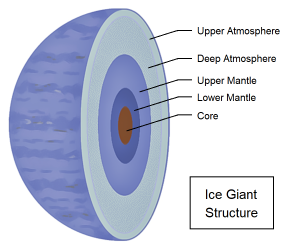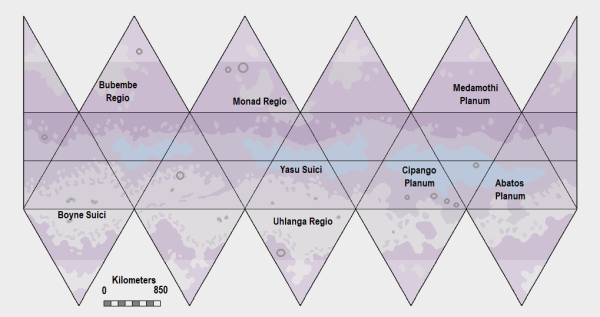Neptune (world)
| Neptune/Sol (Solomani Rim 1827) | |||||||||||||||||||||||||
| Classic Era (1116) | SGG
| ||||||||||||||||||||||||
| See also | UWP | ||||||||||||||||||||||||
| System Details | |||||||||||||||||||||||||
| Primary | G2 V | ||||||||||||||||||||||||
| Planetoid Belts | 1 | ||||||||||||||||||||||||
| Gas Giants | 4 | ||||||||||||||||||||||||
Neptune is a barren fluid hellworld with oceans of a liquid other than water such as ammonia, methane, or hydrocarbons, or other exotic liquids.
- This world has no overt population, government, or law level.
- Hellworlds often offer daily, and sometimes hourly, life-threatening situations to their inhabitants.
- This world could be populated if anyone had an inclination to do so...
- It is a member of the Third Imperium in the Sol Subsector of Solomani Rim Sector in the Domain of Sol.
- It is an ice giant with a ring system and many moons.
- It is a secondary world within the Terra system.
| Neptune / Terra System | |||
| Sol/Solomani Rim 1827 | |||
| Position | Distance | Name | UWP |
| Primary | Sol | G2 V | |
| 9 | 29.90 AU | Neptune | Small GG |
| 1 | 1.0 Diam | Rings | YR00000-0 |
| 2 | 1.3 Diam | Galatea | YS00000-0 |
| 3 | 1.5 Diam | Larissa | YS00000-0 |
| 4 | 2.4 Diam | Proteus | YS00000-0 |
| 5 | 7.2 Diam | Triton | H210169-E |
| 6 | 112 Diam | Nereid | YS00000-0 |
Description (Astrography & Planetology)
Neptune orbits Sol, a solitary primary star.
- It is a yellow main sequence.
Monostellar System
Jupiter Monostellar System Star Name Hierarchy Category Mass (Sol) Temp (K) Luminosity (Sol) Sol G2 V
Primary Main Sequence 1 5720 - 5770 1 Unit Diameter Min Distance Hab Zone Jump Shadow M-Drive Limit AU 0.0047 0.0829 0.95 - 1.68 0.47 4.7 Orbit # * * 4 1 6 Remarks None
System Data
The primary of the Terra system is Sol, an ordinary yellow main sequence star. It has a luminosity of 1 Sol, a mass of 1 Sol, and a diameter of 1.391 million km. Sol retains a family of four inner rocky worlds (Mercury, Venus, Terra, and Mars), a stony planetoid belt, and four outer gas giant worlds (Jupiter, Saturn, Uranus, and Neptune). The Kuiper Belt, an outer icy planetoid belt, exists at the system fringe but is rarely counted as a distinct world, despite containing a number of significant bodies. The system is named for Terra, the mainworld, the third world out from the star and orbiting within its habitable zone.
- Mercury
- Venus
- Terra (including Luna)
- Mars
- Asteroid Belt (including Ceres)
- Jupiter (including Ganymede)
- Saturn (including Rhea)
- Uranus
- Neptune
- Kuiper Belt (including Pluto-Charon)
Neptune is the outermost of the four outer gas giant worlds. It is classified as an ice giant and orbits within the outer system.
- Neptune retains five major moons and nine minor moons. Traditionally, only the major moons are listed on the world's UWP Listing.
- Some UWP Listings only include Triton, the largest moon, and Nereid (considered broadly representative of the world's many smaller moons).
- A mining facility that also serves as a refueling station is located on Triton.
The Terra system has been settled for thousands of years and is dotted with facilities and constructions, space stations, satellites and probes, and numerous sophont-made objects and debris.
NEPTUNE and its moons:
Orbit Name UWP Remarks Orbital Period
----------------- -------------------- ------------ ------------------------------ -------------------
Primary Sol G2 V
29.9 AU Neptune SGG Diameter 49,244 km 164 years 299 days
1.0 Diam Naiad YD00000-0 7.1 hours
1.0 Diam Ring System YR00000-0 --
1.0 Diam Thalassa YD00000-0 7.5 hours
1.1 Diam Despina YD00000-0 8.0 hours
1.3 Diam Galatea YS00000-0 10.3 hours
-------------- ------------------- ------------ ------------------------------- --------------
1.5 Diam Larissa YS00000-0 13.3 hours
2.2 Diam Hippocamp YD00000-0 23.0 hours
2.4 Diam Proteus YS00000-0 26.9 hours
7.2 Diam Triton H210169-E Refuelling station 5.9 days
-------------- ------------------- ------------ ------------------------------- --------------
112.0 Diam Nereid YS00000-0 360.1 days
339.0 Diam Halimede YD00000-0 5.1 years
460.0 Diam Sao YD00000-0 8.0 years
480.0 Diam Laomedeia YD00000-0 8.7 years
949.0 Diam Psamathe YD00000-0 25.7 years
1021.0 Diam Neso YD00000-0 26.7 years
Neptune
Neptune has a UWP classification of "SGG" and is categorised as an ice giant. It orbits Sol at a mean distance of 29.9 AU (778.5 million km) and has an orbital period of 164 years 299 days. It has a mean rotation period (a local day) of 16.1 standard hours, although the surface is not rigid and different regions of (and altitudes within) the world rotate at different rates. Neptune has a diameter of 49,244 km, a mean density of 1.64 g/cm³, a surface gravity of 1.14 G, and a complex layered internal structure.
- Its surface is defined as the point within the upper atmosphere where the mean pressure equals one atm (760.0 mm Hg), equivalent to the mean surface atmospheric pressure of Terra.
Core
The core of the world is large and rocky and relatively metal-rich compared to other types of gas giant worlds. It has a radius of approximately 7,500 km. It is primarily composed of small quantities of heavy elements such as nickel (Ni) and iron (Fe), trace elements including thorium (Th) and uranium (U), and substantial concentrations of silicates (SiO 4–). The core temperatures exceed 7,000°C and pressures exceed 7 megabars. The core is dynamic and active, retaining residual heat from its formation and generating additional heat through gravitational pressure and the decay of radioactive elements contained within it.
Mantle
Above the core is a dense mantle with a depth of around 5,000 km. It is a superheated region where temperatures can reach as high as 4500°C. It has a composition of water (H2O), methane (CH4), and ammonia (NH3) in the form of extremely compressed high temperature ices and slush. It is hot and extremely viscous, though it is able to flow throughout its entire depth: this movement generates the worlds magnetosphere.
- Under the intense pressures within the upper mantle methane molecules (CH4) break apart, releasing their carbon and hydrogen. The carbon bonds with other free carbon present in the dense chemical mix, forming long chains: these continue bonding, creating crystalline structures resembling diamonds. The dense diamond formations then drop down through the layers of the mantle until they vaporize, becoming free carbon again.
Deep Atmosphere
The deep atmosphere has a depth of around 9,000 km. It has a composition of 80% Hydrogen (H2), 18% Helium (He), and 2% methane (CH4), ammonia (NH3), water (H2O), and other trace gases. The water-ammonia ocean that forms the upper mantle graduallty transitions into gases, with concentrations decreasing with altitude. Clouds made up of ammonia and hydrogen sulfide exist at higher pressures.
Upper Atmosphere
The upper atmosphere begins at the altitude within the ice giant where the mean atmospheric pressure equals 1 atm, equivant to the surface atmospheric pressure of Terra: this is considered to be the surface of the world. The upper atmosphere has a depth of around 3,100 km and is divided into the troposhere, the thermosphere, the stratosphere, and the exosphere, and gives way to the vacuum of space when the mean pressure drops below 0.001 atm. It primarily consists of hydrogen (H2) and helium (He), with trace amounts of other gases including methane (CH4), ammonia (NH3), and water vapor (H2O). The upper atmosphere is generally transparent or hazy, with white ammonia or water vapor clouds carried by extremely high speed winds.
Coloration
The methane (CH4) present in Neptune's atmosphere absorbs red wavelengths of light but reflects blue wavelengths back into space, giving the world its characteristic blue color.
Weather Systems
Neptune has the strongest winds of any world within the Terra system. Winds whip clouds of frozen methane across the planet at speeds of around 2000 kph. Storms can form within hours and expand to become thousands of kilometers in diameter.
- Storms generate powerful bolts of lightning, frequently measuring hundreds of kilometers in length and arcing between banks of clouds. Electrical storms can occur anywhere within the atmosphere but are most common within water vapor (H2O) clouds within the troposphere.
- Different types of precipitation occur within certain regions and altitudes of the atmosphere and can take the form of hazes, fogs, rain, chemical snow, or even solid silicates: the deeper within the atmosphere, the more extreme the nature of the precipitation. The chemical nature of the precipitation is closely associated with the clouds prevalent at the level at which the precipitation occurs. Deep within the world's mantle the precipitation takes the form of diamonds.
Magnetosphere
Neptune's magnetic fields are caused by convective motions in the electrically conductive fluids of the mantle. The world's magnetosphere balloons out to around 600,000 km (around 13 Neptune diameters) towards Sol, the systems star and trails out to 1.75 million km (around 36 Neptune diameters) in the solar wind. The magnetosphere creates a cavity in the solar wind that the Shepherd Moons and Inner Moons orbit within. Beyond the magnetosphere is the magnetopause, where Neptune’s magnetic field becomes weak and the solar wind interacts with matter originating from the planet.
- Powerful electrical currents generated deep within the mantle of Neptune create the worlds magnetic fields.
- Near the planet, the magnetic fields trap swarms of charged particles and accelerate them to very high energies, creating belts of intense radiation.
- The rings, the Shepherd Moons, and the Inner Moons are saturated with high levels of radiation.
Rings and Satellites
Ring System
Neptune has five distinct rings represented by the single UWP Code YR00000-0. They are named the Galle, Le Verrier, Lassell, Arago, and Adams rings. The world's Shepherd Moons orbit among them.
- The Galle ring is about 2000 km wide and lies between 41,000 km–43,000 km (from 0.83 diameters to 0.88 diameters) from Neptune. It is a faint ring largely composed of dust.
- The Le Verrier ring is about 110 km wide and lies at approximately 53,100 km (about 1.08 diameters) from Neptune. It lies within (but is a separate structure to) the inner edge of the Lassell ring.
- The Lassell ring is about 4000 km wide and lies around 53,000 km–57,000 km (from 1.08 diameters to around 1.16 diameters) from Neptune. It is a faint ring composed of icy fragments and dust.
- The Arago ring is about 100 km wide and lies at approximately 57,100 km (about 1.16 diameters) from Neptune. It lies within (but is a separate structure to) the outer edge of the Lassell ring.
- The Adams ring is about 35 km wide and lies at approximately 64,000 km (about 1.30 diameters) from Neptune. It is narrow, inclined, and is slightly eccentric. The small moon Galatea, which orbits just inside of the ring, shepherds the ring particles, keeping them inside a narrow range of orbital radii.
Satellites
Neptune has fourteen moons. Of these, five are considered major (denoted by names in bold) and the remaining nine are considered minor. They also fall into three distinct groups, labelled Shepherd Moons, Inner Moons, and Outer Moons:
Shepherd Moons, orbiting between the ice giant's faint rings and helping to maintain their form and structure.
- Naiad (diameter 66 km, orbiting at 0.97 Neptune diameters), Thalassa (diameter 80 km, orbiting at 1.02 Neptune diameters), Despina (diameter 152 km, orbiting at 1.07 Neptune diameters), and Galatea (diameter 204 km, orbiting at 1.26 Neptune diameters).
Inner Moons, lying beyond Neptune's ring system but orbiting within the world's magnetosphere.
- Larissa (diameter 216 km, orbiting at 1.50 Neptune diameters), Hippocamp (diameter 35 km, orbiting at 2.14 Neptune diameters), Proteus, (diameter 424 km, orbiting at 2.39 Neptune diameters), and Triton (diameter 2700 km, orbiting at 7.20 Neptune diameters).
Outer Moons, orbiting at huge distances from Neptune, far beyond the world's magnetosphere.
- Nereid (diameter 340 km, orbiting at 112 Neptune diameters), Halimede (diameter 62 km, orbiting at 339 Neptune diameters), Sao (diameter 44 km, orbiting at 460 Neptune diameters), Laomedeia (diameter 42 km, orbiting at 480 Neptune diameters), Psamathe (diameter 38 km, orbiting at 949 Neptune diameters), and Neso (diameter 30 km, orbiting at 1021 Neptune diameters).
Major Satellites
The terms major and minor are related to the satellite's size: Neptune's major satellites have diameters of 200 km or more, while minor satellites are smaller and have Size Code D (denoting Debris, an object too small to be self-rounding due to its own gravity). The major satellites were all discovered during the early period of Terrans studying their home system, while most of the minor moons were discovered later, when a robotic deep space mission launched from Terra passed by Neptune in -2530.
Galatea
Galatea (UWP YS00000-0) is the inner of the five major moons of Neptune and is classified as a worldlet. It orbits its parent world at a mean distance of 1.26 diameters (62,000 km), with an orbital period of 10.3 hours: it is tidally locked to Neptune. Galatea is an irregular spheroid with a long axis of 204 km, a density of 0.75 g/cm³ and a surface gravity of 0.0018 G. The atmosphere is rated as vacuum. The world has no surface hydrosphere. Mean surface temperature: -222°C. It is composed of a mixture of crystalline water-ice (H2O) and crystalline methane-ice (CH4), with small quantities of frozen ammonia (NH3), nitrogen (N2) and silicates (SiO 4–). The crust is broadly similar in composition to the interior and contains trace amounts of tholins.
- Galatea is the largest and outermost of Neptune's Shepherd Moons, orbiting just within the outer Adams ring and helping to maintain that structure.
Larissa
Larissa (UWP YS00000-0) is the second of the five major moons of Neptune and is classified as a worldlet. It orbits Neptune at a mean distance of 1.50 diameters (73,500 km), with an orbital period of 13.3 hours. Larissa is an irregular flattened spheroid with a long axis of 216 km and a maximum thickness of 168 km, a density of 1.2 g/cm³, and a surface gravity of 0.003 G. The world has no surface hydrosphere. Mean surface temperature: -223°C. It is composed of a mixture of crystalline water-ice (H2O) and crystalline methane-ice (CH4), with small quantities of nitrogen (N2) and silicates (SiO 4–). The crust is broadly similar in composition to the interior.
- The tiny moon is slowly spiralling inward towards Neptune due to tidal deceleration. It may eventually break up into a planetary ring upon passing its parent world's Roche limit.
Proteus
Proteus (UWP YS00000-0) is the third of the five major moons of Neptune and is classified as a worldlet. It orbits Neptune at a mean distance of 2.39 diameters (117,600 km), with an orbital period of 26.9 hours. Proteus is an irregular spheroid with a long axis of 424 km, a density of 1.3 g/cm³, and a surface gravity of 0.007 G. The world has no surface hydrosphere. Mean surface temperature: -222°C. It is composed of a mixture of crystalline water-ice (H2O) and crystalline methane-ice (CH4), with small quantities of nitrogen (N2) and silicates (SiO 4–).
- Proteus is heavily cratered and is rugged, with many rilles and ridges across its surface. The largest crater is called Pharos and has a diameter of around 250 km and a depth of around 15 km.
Triton
Triton (UWP H210169-E) is the fourth and largest of the five major moons of Neptune and is classified as a worldlet. It orbits Neptune at a mean distance of 7.20 diameters (355,000 km), with an orbital period of 141.5 hours. It has a retrograde orbit (it orbits in the opposite direction to Neptune's rotation), it orbits at an angle of 157° relative to Neptune's equatorial plane, and has a rotation period of 141.5 hours (the same as its orbital period): it permanently keeps one face towards Neptune.
- Triton is believed to be a large Kuiper Belt Object captured by Neptune's gravity many millions of years ago.
The world has a diameter of approximately 2700 km, a density of 2.06 g/cc, and a surface gravity of 0.08 G. It has a crust consisting of frozen nitrogen over an icy mantle surrounding a small core composed of silicates and metals. The surface is cratered and fractured and covered in layers of dust, regolith, and deposited material. The mean surface temperature is -235°C. Triton's mean atmospheric pressure is below 0.001 atmospheres, qualifying it as a vacuum world: what miniscule trace of atmosphere there is consists of 99.9% nitrogen and 0.1% methane. Energy from Sol irradiates this gaseous mixture, producing tholins, pinkish nitrogen-rich organic (but non-biological) substances that drop onto and stain large areas of the worlds surface.
Energy from Sol causes nitrogen to sublimate within the crust: tidal stresses on the world cause weak spots, allowing geysers to erupt that spew icy material from the mantle upward to more than 8 kilometers above the surface. The majority of ice geysers occur within the southern regions of the world, in the Boyne Suici and Uhlanga Regio regions.
- Multiple geysers can be active at the same time and their ejected material drifts for hundreds of kilometers before settling. In the extremely low gravity the falling material can take many hours to reach the surface: this falling icy material is represented by the world's trace atmosphere rating.
- A refuelling station serviced by a Class H Spaceport is located on the surface. A small outpost supports operations and has a population of a few dozen individuals. It is part of the Leverrier Complex, an aging mining facility.
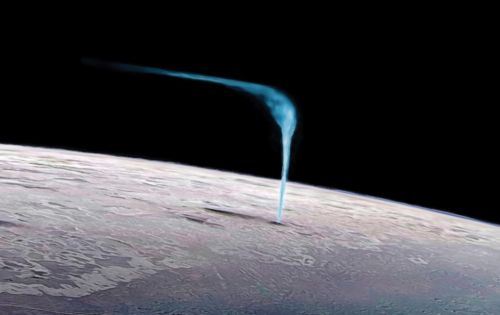
An ice geyser erupting from the surface of Triton.
Nereid
Nereid (UWP YS00000-0) is the outer of the five major moons of Neptune and is classified as a worldlet. It orbits Neptune at a mean distance of 112 diameters (5.504 million km), with an orbital period of 360.1 days. Nereid is an irregular spheroid with a long axis of 357 km, a density of 1.5 g/cm³, and a surface gravity of 0.007 G. The world has no surface hydrosphere. Mean surface temperature: -222°C. It is composed of a mixture of crystalline water-ice (H2O), silicates (SiO 4–), crystalline methane-ice (CH4), and small quantities of nitrogen (N2).
- Halimede, a tiny minor moon orbiting at 339 diameters, displays very similar physical characteristics to Nereid: it may be a fragment of Nereid that was broken off as a result of a collision.
Native Lifeforms
No lifeforms are known to exist within Neptune's atmosphere or on any of its moons.
History & Background (Dossier)
Neptune is an ice giant, a type of small gas giant, located in the outer fringe of the Terra system in Sol Subsector of the Solomani Rim. The world was first observed by Terran astronomers in -2673 and was first visited in -2530, by a deep space robotic probe. The world orbits very close to the inner edge of the Kuiper Belt.
World Spaceport (St)
Neptune does not have a spaceport.
World Demographics (P)
Neptune is unpopulated.
World Technology Level (T)
Neptune possesses a Tech Level of TL–0.
- The world has no technological base.
World Government (G)
Neptune has no government or direct ruling authority of any kind.
World Law (L)
Neptune has no law level. No laws of any kind are enforced.
Imperial High / Landed Nobility
Only the mainworld of a system possesses an officially appointed or landed Imperial Noble.
Image Repository
TravellerMap (T5SS):
[1]
References
| This article is missing content for one or more detailed sections. Additional details are required to complete the article. You can help the Traveller Wiki by expanding it. |
- Board Game: Imperium
- Classic Traveller Signal GK (book)
- John Harshman, Marc Miller. Solomani (Game Designers Workshop, 1986), 1-48.
- John Harshman. The Solomani Rim (Game Designers Workshop, 1982), TBD. (Supplement 10)
- James Holden, Joe D. Fugate Sr., Terrance McInnes. Vilani & Vargr (Digest Group Publications, 1990), 11,47. (dotmap provided)
- Periodical: MegaTraveller Travellers' Digest No. 13 in Article: "The Trouble With Kids"
- Kevin Knight. Traveller Chronicle 10 (Sword of the Knight Publications, 1996), TBD.
- Kevin Knight. Traveller Chronicle 11 (Sword of the Knight Publications, 1996), TBD.
- Kevin Knight. Traveller Chronicle 12 (Sword of the Knight Publications, 1997), TBD.
- Periodical: MegaTraveller Travellers' Digest No. 13
- Jon F. Zeigler. Rim of Fire (Steve Jackson Games, 2000), .
- GURPS Traveller: Interstellar Wars
- Mongoose Traveller: Solomani Rim
- ↑ "Jump Map API" and map location from Travellermap.com

